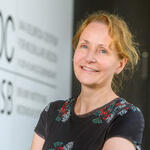Grand finale for European genome project
Dr. Altmüller, what role did the Max Delbrück Center play in the EASI-Genomics consortium?
We were responsible for coordinating transnational access. There were five rounds of calls for project proposals, each with a slightly different focus, for which we received a total of almost 400 applications. In a two-stage review process involving external reviewers, we allocated the 177 approved projects among twelve large centers in Europe. Each has its own expertise, specializing in specific genomic analyses. At the Max Delbrück Center, for example, where Dr. Sonja Hansen and Dr. Thomas Conrad were involved in EASI-Genomics alongside myself, our strength is single-cell analysis and spatial technologies. Our job was to find out which center would be the best host for a planned project and to provide researchers with access to the relevant infrastructure.
Dr. Janine Altmüller, head of the Genomics Platform
What goals have you achieved thanks to EASI-Genomics?
Exchange with other genomics platforms, some of which are very large and extremely well equipped – for example, the Centro Nacional de Análisis Genómico (CNAG for short) in Barcelona and the SciLifeLab in Stockholm – was particularly important. Together, we developed and optimized new methods. That was very inspiring.
Which projects were particularly valuable for the Max Delbrück Center and for Berlin as a research hub?
It’s really hard to say. There are so many! One example is a single-cell analysis in which researchers studied how the placenta changes when the expectant mother smokes. The project has produced very good results and many new collaborations in Berlin, including with Charité and other technology platforms here at the Max Delbrück Center. There are exciting follow-up projects.
And what project from European partners particularly impressed you?
That’s not an easy question as well. The spectrum went far beyond what we normally work on. There were botanical, zoological, ecological and evolutionary biology projects. I was particularly impressed by what researchers at the University of Tartu in Estonia did. They were able to analyze trace amounts of highly fragmented DNA from ancient bones, using it to draw conclusions about how our ancestors lived. For example, two tribes of prehistoric peoples – one hunters, the other gatherers – at some point genetically intermingled despite their very different physiques and completely different diets.
To what extent was EASI-Genomics affected by the COVID-19 pandemic?
We had difficulty meeting, and communication was severely limited – like everywhere else. Exchanges between labs had been planned to provide cross-lab training. Unfortunately, hardly any of them took place. On the positive side, the consortium mobilized tremendous resources for COVID-19 research. There was a call for COVID-19 project proposals in May 2020, and many findings made their way very quickly into prestigious journals. So far, seven projects have produced 18 publications. This kind of consortium can really make a difference.
Can you give an example?
For a study in “Science”, one group of researchers investigated the extent to which an individual's genetic makeup influences the course of COVID-19. The authors had come across autoantibodies that target certain inflammatory messengers. Patients with a severe course of the disease had produced more of them. These findings make it is possible to identify people at the highest risk for a life-threatening case of COVID-19. But this study is really just one piece of the puzzle. Much exciting work has been done, and quite a few publications are still to follow.
On May 4, the official closing event of EASI-Genomics will take place at the Kaiserin-Friedrich-Haus in Berlin. What are you especially looking forward to?
As a technologist, I am of course particularly excited about the upcoming technology spectacle. There will be outstanding speakers, like Professor Mats Nilsson from SciLifeLab in Stockholm and Profossor Nikolaus Rajewsky from the Max Delbrück Center, two visionaries who have developed highly innovative methods. All scientists who use genomic techniques will gain inspiration for their work at this event.
What’s next? Will the project continue to influence genome research after it is over?
We very much hope so. In any case, the EASI-Genomics partners plan to continue working together. To that end, we will have an internal meeting on May 5 to explore future opportunities for collaboration and funding. I am very excited about that.
Anke Brodmerkel conducted the interview.








